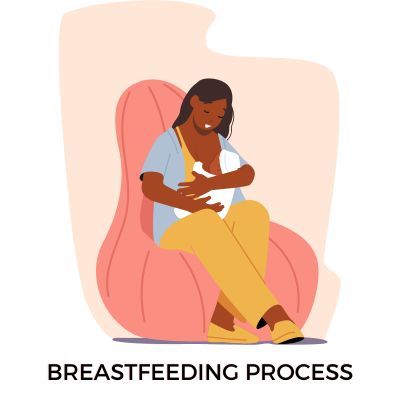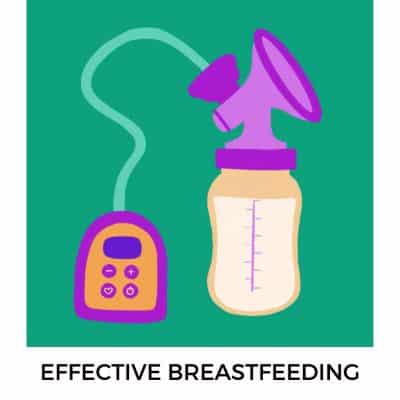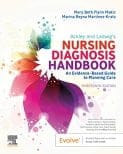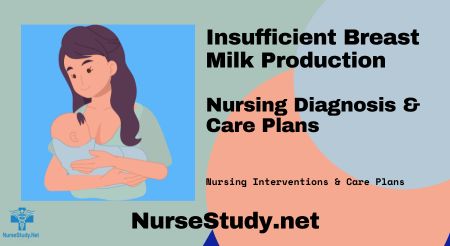Insufficient breast milk production is a common problem that affects many new mothers. It can be caused by a variety of factors, including hormonal imbalances, stress, fatigue, and poor nutrition.
When a mother is unable to produce enough milk to meet her baby’s needs, it can lead to a range of complications, including poor weight gain, dehydration, and even failure to thrive.
Understanding Insufficient Breast Milk Production
Insufficient breast milk production is a common concern for mothers who are breastfeeding their infants.
It is defined as the inability of a mother to produce enough milk to meet the nutritional needs of her child. In this section, we will discuss the defining characteristics, related factors, and diagnostic code for this nursing diagnosis.
Defining Characteristics
The defining characteristics of insufficient breast milk production include:
- Inadequate weight gain or weight loss in the infant
- Poor latch or sucking ability of the infant
- Insufficient urine output or dehydration in the infant
- Incomplete breast emptying during feeding
- Insufficient milk supply
- Fussiness or irritability in the infant during or after feeding
Related Factors
The related factors for insufficient breast milk production can be categorized into maternal and infant factors:
Maternal Factors
- Insufficient glandular tissue in the breasts
- Hormonal imbalances
- Previous breast surgery
- Stress or anxiety
- Lack of proper nutrition or hydration
- Certain medications
Infant Factors
- Ineffective latch or sucking technique
- Infrequent or short feedings
- Premature birth or low birth weight
- Medical conditions or infections
Diagnostic Code
The diagnostic code for insufficient breast milk production is “00002” as per the NANDA-I (North American Nursing Diagnosis Association International) classification. This code is used to identify the nursing diagnosis and develop a care plan for the mother and infant.
It is important to note that insufficient breast milk production does not always mean that a mother cannot breastfeed her infant.
In some cases, supplementation with formula or donor breast milk may be necessary to ensure that the infant receives adequate nutrition. Additionally, lactation consultants and healthcare providers can provide support and guidance to help mothers increase their milk supply and improve feeding techniques.
Assessment and Diagnosis
Assessment
The nurses assessment is the first step in identifying the nursing diagnosis of insufficient breast milk production.
The assessment should include a comprehensive history of the mother, including any medical conditions, medications, and previous breastfeeding experiences.
The assessment should also include an evaluation of the infant’s feeding patterns, weight gain, and overall health. A lactation consultant can be a valuable resource in conducting a thorough assessment.
Nursing Diagnosis
The nursing diagnosis of insufficient breast milk production is based on the nurses assessment findings. The diagnosis is made when the mother is unable to produce enough milk to meet the infant’s nutritional needs. The diagnosis is also made when the infant is not gaining weight appropriately or is showing signs of dehydration.
Knowledge is an essential component in the nursing diagnosis of insufficient breast milk production. The mother should be educated on proper breastfeeding techniques, including positioning, latch, and frequency of feeding. The mother should also be informed of the benefits of breastfeeding and the potential risks of formula feeding.
Pain can also be a contributing factor to insufficient breast milk production. Pain can interfere with the letdown reflex, which can lead to decreased milk production. The mother should be assessed for any pain or discomfort during breastfeeding and provided with appropriate interventions.
Weight gain is an important indicator of the infant’s nutritional status. The infant’s weight should be monitored regularly to ensure appropriate growth and development.
A lactation consultant can be a valuable resource in the nursing diagnosis of insufficient breast milk production. The lactation consultant can provide support and education to the mother and assist with developing a care plan to increase milk production.
In conclusion, the nursing diagnosis of insufficient breast milk production requires a comprehensive nurses assessment of the mother and infant. The diagnosis is based on the assessment findings and is supported by knowledge, pain, weight gain, and lactation consultant interventions.
Interventions and Care
Nursing Interventions
Interventions include providing support and education to the patient on breastfeeding techniques, positioning, and latch-on. Providers may recommend pumping to increase breast milk production and ensure adequate breast emptying.
They may also suggest nutritional interventions to improve the patient’s nutrient intake, such as increasing glucose and water intake. Emotional support is also crucial to address postpartum depression and promote oxytocin release.
Nursing Activities
Nursing activities involve assessing the patient’s breastfeeding difficulties, such as ineffective breastfeeding, and providing interventions to improve breastfeeding success.
Providers should also monitor the patient’s breast milk production and weight loss to ensure adequate breast milk supply and infant nutrition. They may also address engorgement, blocked ducts, and mastitis through positioning, massage, and warm compresses.
NIC Interventions
NIC interventions for insufficient breast milk production nursing diagnosis include providing emotional support, education, and counseling to the patient. Healthcare professionals may also recommend skin-to-skin contact, breastfeeding frequently, and using a breast pump to increase breast milk production. They may also address malnutrition and dehydration through nutritional interventions and increasing fluid intake.
Insufficient Breast Milk Production Nursing Care Plan
The nurses care plan should include interventions to improve breastfeeding success, such as providing education and support on breastfeeding techniques, positioning, and latch-on. The plan should also address nutritional interventions, emotional support, and monitoring milk production and weight loss. Care providers should also provide recommendations for pumping and addressing engorgement, blocked ducts, cracked nipples, insufficient emptying, and mastitis.
Nursing Diagnosis for Mastitis
Insufficient breast milk production related to painful and engorged breasts.
Expected Outcomes:
- Resolution of symptoms, including breast pain, redness, and fever.
- Improved breast milk production and milk flow.
- Enhanced knowledge and skills in breastfeeding techniques and proper breast care.
Nursing Assessment and Rationale
- Assessment of breast appearance and tenderness:
Rationale: This helps in identifying signs of engorgement, redness, and tenderness, which are common indicators of mastitis. Assessing the affected breast(s) allows for proper evaluation and monitoring of the condition. - Evaluation of vital signs, including temperature:
Rationale: Monitoring the patient’s temperature helps in detecting signs of infection, such as fever, which is a common symptom of mastitis. Elevated temperature indicates the need for appropriate interventions and potential antibiotic therapy. - Observation of breastfeeding technique and latch:
Rationale: Assessing the mother’s breastfeeding technique and the baby’s latch is essential to identify any underlying issues that may contribute to inadequate milk removal. Poor latch and ineffective sucking can lead to insufficient milk production and mastitis. Appropriate interventions can be implemented to improve breastfeeding effectiveness. - Assessment of maternal breast milk production and satisfaction:
Rationale: Understanding the mother’s perception of her milk production and the baby’s satisfaction after feedings helps in evaluating the effectiveness of breastfeeding. Insufficient milk production can contribute to mastitis, and assessing the mother’s concerns and expectations allows for individualized support and interventions.
Nursing Interventions and Rationales
- Encourage frequent and effective breastfeeding or breast pumping:
Rationale: Regular breastfeeding or breast pumping helps in improving milk removal, reducing breast engorgement, and promoting milk production. Emptying the breasts adequately can help resolve mastitis and stimulate increased milk supply. - Provide education on proper breastfeeding technique and positioning:
Rationale: Instructing the mother on correct breastfeeding techniques, including proper latch, positioning, and breast care, promotes effective milk removal and reduces the risk of mastitis. Education empowers the mother to address issues related to insufficient milk production and prevent future episodes of mastitis. - Support warm compress application before breastfeeding:
Rationale: Applying a warm compress to the affected breast before breastfeeding can help improve milk flow and relieve breast pain. Heat promotes blood circulation and milk let-down, facilitating milk removal and resolution of mastitis symptoms. - Encourage adequate rest and self-care:
Rationale: Rest and self-care are crucial for the mother’s overall well-being and recovery. Encouraging the mother to prioritize rest, manage stress levels, and practice good hygiene can support healing and prevent recurrent episodes of mastitis. - Collaborate with the healthcare provider for appropriate antibiotic therapy:
Rationale: In cases where mastitis is accompanied by infection, antibiotic therapy may be necessary. Collaboration with the healthcare provider ensures the selection of appropriate antibiotics based on culture and sensitivity results, promoting effective treatment of mastitis. - Provide emotional support and counseling:
Rationale: Mastitis can be physically and emotionally challenging for the mother. Offering emotional support, active listening, and counseling services can help alleviate anxiety, address concerns, and promote a positive breastfeeding experience.
Evaluation Objectives and Criteria
Evaluation objectives and criteria should include monitoring the patient’s breastfeeding success, milk production, and weight loss. One should also assess the patient’s emotional well-being and provide support and counseling as needed. The evaluation should also address any breastfeeding difficulties, such as engorgement, blocked ducts, and mastitis, and provide interventions to address these issues.
Breastfeeding Techniques and Support

Breastfeeding is a natural process that can be both rewarding and challenging for new mothers. There are several techniques and positions that can help mothers successfully breastfeed their babies. Additionally, lactation consultants can provide valuable support and guidance to mothers who are experiencing breastfeeding challenges.
Lactation Consultants
Lactation consultants are professionals who specialize in helping mothers with breastfeeding. They can provide guidance on breastfeeding techniques, help mothers address breastfeeding challenges, and offer emotional support. Lactation consultants can be found in hospitals, clinics, and private practices.
Breastfeeding Techniques

There are several techniques that mothers can use to help their babies latch on and breastfeed successfully. These include:
- Breast massage: Massaging the breast before and during breastfeeding can help stimulate milk flow.
- Hand expression: Hand expression can help mothers express milk and relieve engorgement.
- Breast compression: Breast compression can help increase milk flow during breastfeeding.
Breastfeeding Positions
There are several breastfeeding positions that can help mothers and babies breastfeed comfortably and effectively. These include:
- Cradle hold: In the cradle hold, the baby is held in the crook of the mother’s arm.
- Football hold: In the football hold, the baby is held under the mother’s arm.
- Side-lying position: In the side-lying position, the mother and baby lie on their sides facing each other.
Latching On
Latching on is the process of the baby attaching to the breast and beginning to breastfeed. A good latch is important for successful breastfeeding. Mothers can help their babies latch on by:
- Supporting the baby’s head and neck.
- Holding the baby close to the breast.
- Ensuring that the baby’s mouth is wide open before latching.
Skin-to-Skin Contact
Skin-to-skin contact can help promote bonding between the mother and baby and can also help stimulate milk production. Mothers can hold their babies skin-to-skin by placing the baby on their chest with a blanket over their back.
Breastfeeding Challenges
Breastfeeding can be challenging for some mothers. Some common challenges include sore nipples, engorgement, and low milk supply. Mothers who are experiencing breastfeeding challenges should seek support from a lactation consultant or healthcare provider.
Emotional Support
Breastfeeding can be an emotional experience for new mothers. It is important for mothers to have emotional support from their partners, family members, and healthcare providers. Mothers can also seek support from breastfeeding support groups or online forums.
Risk Factors
There are several risk factors that can contribute to breastfeeding challenges. These include:
- Breast surgery: Women who have had breast surgery may experience difficulties with milk production.
- Sucking reflex: Some babies may have difficulty latching on due to a weak sucking reflex.
- Alcohol consumption: Alcohol consumption can affect milk production and can also be harmful to the baby.
In conclusion, breastfeeding techniques and support can help mothers successfully breastfeed their babies. Lactation consultants can provide valuable support and guidance, and there are several techniques and positions that can help mothers breastfeed comfortably and effectively. Mothers who are experiencing breastfeeding challenges should seek support from a healthcare provider or lactation consultant. Emotional support is also important for new mothers who are breastfeeding.
Nutrition and Hydration
When it comes to insufficient breast milk production, nutrition and hydration are crucial factors that can impact milk supply. Adequate nutrition and hydration are necessary for a lactating mother to produce enough milk for her baby. Inadequate intake of essential nutrients and fluids can lead to a decrease in milk production.
Nutrition
A lactating mother needs to consume a well-balanced diet that provides enough calories, protein, and other essential nutrients to support milk production and maintain her own health. Nutrients such as calcium, iron, and vitamins A, C, and D are particularly important for breastfeeding mothers.
It’s important to note that certain foods can affect milk supply and quality. For example, cow’s milk and lactose intolerance can cause diarrhea and upset stomach in some babies, leading to a decrease in milk production. Additionally, some mothers may experience constipation or allergies due to certain foods, which can also impact milk supply.
Fluid Volume
Adequate fluid intake is essential for lactating mothers to maintain milk production. Dehydration can lead to a decrease in milk supply, so it’s important for mothers to drink plenty of water and other fluids throughout the day.
Dehydration
Dehydration can occur when a mother doesn’t consume enough fluids or loses too much fluid through sweating or other means. Signs of dehydration include dark-colored urine, dry mouth, and fatigue. If a mother is dehydrated, her milk supply may decrease, so it’s important to stay hydrated.
In summary, proper nutrition and hydration are essential for lactating mothers to produce enough milk for their babies. Consuming a well-balanced diet that provides enough calories, protein, and essential nutrients, as well as drinking plenty of fluids, can help maintain milk production. Mothers should also be aware of foods that can affect milk supply and quality and make adjustments as necessary.
Complications and Risks
Insufficient breast milk production can lead to various complications and risks for both the mother and the infant. Some of the common complications and risks associated with insufficient breast milk production are discussed below.
Breastfeeding Difficulties
Insufficient breast milk production can cause breastfeeding difficulties, including poor latch, nipple pain, and ineffective milk transfer. These difficulties can lead to frustration and stress for both the mother and the infant, which can further decrease milk production.
Infection
Infants who do not receive enough breast milk may be at increased risk of infection. Breast milk contains antibodies that help protect infants against infections. When infants do not receive enough breast milk, they may be more susceptible to infections such as ear infections, respiratory infections, and gastrointestinal infections.
Weight Loss
Infants who do not receive enough breast milk may experience weight loss or inadequate weight gain. This can lead to malnutrition and developmental delays.
Growth Faltering
Insufficient breast milk production can also lead to growth faltering, which is a failure to thrive or grow at a normal rate. This can result in long-term developmental delays and health problems.
Postpartum Depression
Mothers who experience insufficient breast milk production may be at increased risk of postpartum depression. This can be due to feelings of guilt, inadequacy, and hormonal changes.
Obesity
Infants who do not receive enough breast milk may be at increased risk of obesity later in life. Breast milk contains hormones that help regulate appetite and metabolism, and the lack of these hormones may contribute to obesity.
Breast Cancer
Mothers who do not breastfeed or breastfeed for a short duration may be at increased risk of breast cancer. Breastfeeding has been shown to reduce the risk of breast cancer in mothers.
Diabetes
Infants who do not receive enough breast milk may be at increased risk of developing type 1 diabetes later in life. Breast milk contains factors that help regulate blood sugar levels, and the lack of these factors may contribute to diabetes.
Physiology
Insufficient breast milk production may be due to various physiological factors, including hormonal imbalances, breast surgery, and certain medications.
Placenta
Insufficient breast milk production may also be related to placental problems during pregnancy, such as placental insufficiency or placenta previa.
Colostrum
Failure to produce enough colostrum, the first milk produced by the mother, can lead to a lack of protective antibodies for the infant.
Hind Milk
Insufficient breast milk production can also lead to a lack of hind milk, the higher-fat milk that is released later during a feeding. Hind milk is important for infant growth and development.
Foremilk
Insufficient breast milk production can also lead to a lack of foremilk, the lower-fat milk that is released earlier during a feeding. Foremilk is important for hydration and nutrient intake.
Delayed Milk Production
Delayed milk production can lead to insufficient breast milk production. This can be due to various factors, including premature birth, cesarean delivery, and maternal stress.
Bleeding After Birth
Excessive bleeding after birth can lead to insufficient breast milk production. This can be due to a decrease in blood volume and nutrients available for milk production.
Sudden Infant Death Syndrome
Infants who do not receive enough breast milk may be at increased risk of sudden infant death syndrome (SIDS). Breastfeeding has been shown to reduce the risk of SIDS.
Uterus
Insufficient breast milk production can also lead to delayed uterine involution, which is the process of the uterus returning to its pre-pregnancy size. This can increase the risk of postpartum hemorrhage and other complications.
Challenges
Insufficient breast milk production can lead to various challenges, including the need for supplementation with formula, increased feeding frequency, and the use of breast pumps.
Emptying
Failure to empty the breast completely during feedings can lead to insufficient breast milk production. This can be due to poor latch, ineffective milk transfer, or infrequent feedings.
Blocked Duct
Blocked milk ducts can lead to insufficient breast milk production. This can be due to poor latch, infrequent feedings, or the use of tight clothing or bras.
Mastitis
Insufficient breast milk production can also lead to mastitis or breast infection, which is an inflammation of the breast tissue. Mastitis can cause pain, swelling, sore nipples, and fever, and can lead to a decrease in milk production.
Overall, insufficient milk production can lead to various complications and risks for both the mother and the infant. It is important for mothers to seek support and guidance from healthcare providers and lactation consultants to address any breastfeeding difficulties and ensure adequate milk production.
American Academy of Pediatrics Recommendations
The American Academy of Pediatrics (AAP) recommends exclusive breastfeeding for the first six months of an infant’s life, followed by continued breastfeeding while gradually introducing solid foods until at least 12 months of age and beyond, as long as it is mutually desired by mother and infant.
Breast milk is the best source of nutrition for infants as it contains antibodies that help protect against infections and illnesses. Breastfeeding also has benefits for the mother, such as reducing the risk of breast and ovarian cancer.
If a mother is experiencing insufficient milk production, the AAP recommends seeking support from a lactation consultant or healthcare provider. It is important to address any underlying issues, such as latch or positioning problems, that may be contributing to the issue.
While formula can be used as supplemental feedings or alternative to breast milk, it does not provide the same antibodies and health benefits as breast milk. Additionally, formula contains lactose, which can cause diarrhea or constipation in some infants.
Cow’s milk should not be introduced as a primary source of nutrition until after 12 months of age, as it can cause allergies and other health issues in infants.
The AAP also recommends that infants be placed on their backs to sleep to reduce the risk of sudden infant death syndrome (SIDS). Breastfeeding has been shown to reduce the risk of SIDS, so it is important for mothers to continue breastfeeding even if they are supplementing with formula.
Frequently Asked Questions
What causes low breast milk production?
There can be several reasons for low breast milk production, including hormonal imbalances, inadequate breastfeeding technique, certain medications, and medical conditions such as polycystic ovary syndrome. Stress and lack of sleep can also affect milk production.
How can breastfeeding be improved?
Breastfeeding can be improved by ensuring that the baby is latched on correctly, breastfeeding frequently, and avoiding the use of pacifiers and bottles in the early weeks. Adequate rest, hydration, and nutrition can also help improve milk production.
What are the signs of inadequate milk supply?
Signs of inadequate milk supply may include the baby not gaining weight, not having enough wet or dirty diapers, and appearing fussy or hungry after feeding.
What are some nursing interventions for ineffective breastfeeding?
Nursing interventions for ineffective breastfeeding may include providing support and education to the mother on proper breastfeeding techniques, encouraging frequent feedings, and monitoring the baby’s weight gain.
What is the impact of insufficient breast milk production on the infant?
Insufficient breast milk production can lead to poor weight gain, dehydration, and malnutrition in the infant. It can also increase the risk of infection and illness.
What are some strategies for increasing breast milk supply?
Strategies for increasing breast milk supply may include breastfeeding frequently, pumping between feedings, ensuring adequate rest and nutrition, and seeking support from a lactation consultant or healthcare provider.
References
Gatti L. Maternal perceptions of insufficient milk supply in breastfeeding. J Nurs Scholarsh. 2008;40(4):355-63. doi: 10.1111/j.1547-5069.2008.00234.x. PMID: 19094151; PMCID: PMC4508856.
Kent JC, Ashton E, Hardwick CM, Rea A, Murray K, Geddes DT. Causes of perception of insufficient milk supply in Western Australian mothers. Matern Child Nutr. 2021 Jan;17(1):e13080. doi: 10.1111/mcn.13080. Epub 2020 Sep 20. PMID: 32954674; PMCID: PMC7729526.
Piccolo, O., Kinshella, ML.W., Salimu, S. et al. Healthcare worker perspectives on mother’s insufficient milk supply in Malawi. Int Breastfeed J 17, 14 (2022). https://doi.org/10.1186/s13006-022-00460-1
Best Nursing Books and Resources
These are the nursing books and resources that we recommend.
NurseStudy.net is a participant in the Amazon Services LLC Associates Program. Included below are affiliate links from Amazon at no additional cost from you. We may earn a small commission from your purchase. Please see our Privacy Policy

The Nursing Diagnosis Handbook E-Book: An Evidence-Based Guide to Planning Care
This is an excellent reference for nurses and nursing students. While it is a great resource for writing nursing care plans and nursing diagnoses, it also helps guide the nurse to match the nursing diagnosis to the patient assessment and diagnosis.
This handbook has been updated with NANDA-I approved Nursing Diagnoses that incorporates NOC and NIC taxonomies and evidenced based nursing interventions and much more.

NANDA International Nursing Diagnoses: Definitions & Classification, 2021-2023
All introductory chapters in this updated version of a ground-breaking text have been completely rewritten to give nurses the knowledge they require to appreciate assessment, its relationship to diagnosis and clinical reasoning, and the goal and use of taxonomic organization at the bedside.

Nursing Care Plans: Nursing Diagnosis and Intervention
It contains more than 200 care plans that adhere to the newest evidence-based recommendations.
Additionally, it distinguishes between nursing and collaborative approaches and highlights QSEN competencies.
Disclaimer
Please follow your facility’s guidelines, policies, and procedures.
The medical information on this site is provided as an information resource only and is not to be used or relied on for diagnostic or treatment purposes.
This information is intended to be nursing education and should not be used as a substitute for professional diagnosis and treatment.


